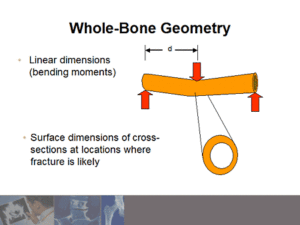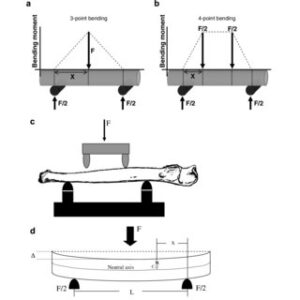“Lateral impact loading of a long bone causes bending. The fracture starts at the tension side (away from the site of impact) and progresses across the bone up to the middle. When it reaches the compressive side, it ‘runs’ along the direction of maximal shear (at 45 to the transverse), creating a butterfly fragment.”<-See Figure 9 of the paper for the image I can’t copy and paste it.
But the above image is basically what happens with the arrow being the point of impact. 3 point bending is another method in the above study that doesn’t really occur physiologically and may be worth trying
But the whole reason behind LSJL in the first place was that the epiphysis is more easily deformable than the diaphysis which is why Yokota developed the joint loading modality.
“when a long bone is impact-loaded in a direction perpendicular to its long axis it bends, such that the side contacted by the impact is loaded in compression, while the opposite side is loaded in tension. As a result, failure will begin on the opposite side to the impact (the tensile side) since it will reach its ultimate strength sooner than the side loaded in compression. As the advancing crack will reach the middle of the bone, it will reach compressed tissue, and due to bone’s higher resistance to this type of load, it will advance in a path nearer to the bone’s longitudinal direction, along the directions of maximal shear stress. In this way it will form a fracture with a so-called ‘butterfly’ fragment, commonly seen in practice “
Lateral impact loading of the spine is kind of studied here:
Impact Loading of the Lumbar Spine During Football Blocking
But I couldn’t really find any interesting insights.
Lateral impact loading in general is generally studied on cartilage because it does not occur really often physiologically.
The effects of lateral impact loading where studied mainly terms of fracture but the forces should be about the same. Instead of loading in the middle we’re putting the impact near the longitudinal ends of the bones but still on the diaphysis. The impact causes compressive and tensile strain in the bone which drives fluid forces(intramedullary pressure, interstitial fluid flow, blood perfusion).
Fluid forces degrade bone and provide the microenvironment for longitudinal bone growth without needing to be in the plastic deformation range.


